Introduction
Cherry is the first temperate non-climacteric stone fruit of Kashmir valley that flushes to the market after winter. Kashmir valley is the largest producer of cherry in India and its cultivation as niche cash crop has picked up at a faster rate. At present the production of cherry is around 10886 metric tons per hectare (Anon 2009 – 2010). The commercially exploited varieties of cherry are ‘Misri’, ‘Double’ and ‘Makhmali’. Cherry is harvested at full maturity to achieve maximum quality in terms of visual appearance, color, texture, flavor and nutritional value. It is highly perishable, susceptible to mechanical injury, physiological deterioration, water loss and has short life due to fast decay caused by fungal infections. The maximum shelf-life of Cherry at ambient (25±2 0C, RH 80%) and refrigeration temperatures (0 – 3 0C, RH 90%) is around 3 and 14 days respectively. The short storage life of the cherry fruit makes its marketing a challenge, hence most of the fruit is consumed locally and around one to two percent of the total produce is marketed to near distant domestic markets. To facilitate the marketing to places other than the local market, augment export trade, maintain quality during storage and establishes price for the grower during the glut season; effective post harvest treatments are needed.
Many studies have been carried out in order to develop new preservation methods. Among the methods tested, gamma irradiation has proved to be effective in reducing bacterial and mold contamination as well as delaying the ripening and senescence of fruits (Molins 2001; Fan et al., 2003). Irradiation has been recognized as an alternative to methyl bromide for treating fresh and dried agricultural products to overcome quarantine barriers in international trade, as a mode of decontamination, disinfestation and for improving nutritional attributes and shelf-life (McDonald et al., 2012; Hong et al., 2008; Teets et al., 2008; Hallman 2000; Lacroix and Ouattara 2000). Literature review reveals that considerable research has been done on irradiation of stone fruits
with respect to quality maintenance and postharvest shelf-life extension. According to McDonald et al., (2012), commercial scale irradiation of six peach varieties (Encore, Blaze Prince, July Prince, Red Globe, Flame Prince and August Lady) at targeted dose of 0.4 kGy did not adversely affect shelf life but enhanced the ripening process; however, this was perceived as positive change by the consumers. Kim et al., (2009) reported that peach varieties respond differently to irradiation, but the greatest impact seems to be on firmness. Hussain et al., (2008) observed a dose dependent loss of firmness and enhancement in anthocyanin accumulation of Elberta peaches irradiated at doses between 1 and 2 kGy. Hussain et al., (2013) in another study reported that dose range of 1.2–1.5 kGy significantly inhibited the decaying of plums Cv. Santroza up to 16 days of ambient storage. Irradiation in combination with refrigeration prevented the decaying of plums up to 35 days as against the 12.5% decay in un-irradiated control samples. However, the literature so far published regarding the radiation processing of cherry represent varying results and most of the work done pertains to ‘Rainier’, ‘Bing’, and ‘Lambert’ varieties only. Jessup (1990) reported no quality change in ‘Bing’ and ‘Lambert’ cherries at irradiation doses above 75 Gy. Drake and Neven (1997) reported that in ‘Bing’ and ‘Rainier’ sweet cherries irradiated in the dose range of 0.15 – 0.9 kGy, no change in total soluble solids, titratable acidity or flavor were noted at any of the irradiation doses. However, defects were more in ‘Rainier’ cherries irradiated at doses above 0.6 kGy compared to ‘Bing’ Cherries. Drake et al.,(1994) reported that ‘Rainier’ sweet cherries were tolerant than ‘Bing’ to irradiation dose levels of 1.0 kGy or less with little quality loss except for a reduction in firmness. The literature survey also indicates that there hardly seems any information available till this date regarding the radiation processing of cherry varieties of Kashmir origin. Therefore, the present study was conducted to investigate the effect of gamma irradiation on storage quality, shelf-life extension and facilitating the marketing of fresh cherries from Kashmir to distant places other than local market.
Materials and Methods
The study was conducted consecutively for two years during 2008–2010. Fruit selection was done from same orchard and harvesting was carried out in the first week of June for both the years of study. The results showed similar behavior for both the years and the data presented for each parameter is the average of the means of two years of study.
Raw Material Preparation
Cherry fruit of proper commercial maturity, uniform size and color and without any signs of damage or fungal decay were procured from the cherry orchards of Harwan, Kashmir. Selection of fruit was done from the same orchard and fruit was harvested during early morning hours. The harvested fruit was then transported to the Nuclear Research Laboratory and was kept at 20C in a cold storage room. The pre-cooled fruit was manually graded in order to have uniformity in size and color and any blemished or injured fruits present were discarded. The graded fruit was packed in cardboard boxes of size 0.5 m × 0.3 m × 0.3 m each containing 250 g of fruit.
Gamma Irradiation Treatment
The pre-cooled and packaged fruit was subjected to gamma-irradiation in the range of 0.3–1.5 kGy using a PANBIT irradiator having Co-60 as the gamma-ray source. The fruit was irradiated at a minimum dose rate of 145 Gy/h. To ensure uniformity of dose, boxes were turned by 1800 half-way through the irradiation time and the over dose ratios (Dmax/Dmin) was determined and found to be 1.3. The dose rate was determined by using Ceric-Cereous dosimetry.
Fruit Analysis
After irradiation, the fruit was kept separately under ambient (temp. 25±2 0C, RH 70%) and refrigerated (temp.3±1 0C, RH 80%) storage conditions and periodically evaluated for physico-chemical, sensory and microbiological parameters. Three boxes each containing 250 g of fruit were evaluated for each parameter and treatment after every 3 days in case of ambient storage and every 7 days in case of refrigerated storage. Prior to the analysis of samples kept under refrigerated conditions, fruits were allowed to attain the room temperature.
Firmness and Titratable Acidity Measurement
Firmness was determined using the Universal TA-XT2 texture analyzer equipped with a 3 mm probe set at 10 mm/s and a penetration distance after contact of 7 mm and the values were expressed in Newton (N). Triplicate samples were used for determination of firmness and each replicate consisted of 25 fruits. The fruits initially used for firmness measurement were subjected to juice extraction using laboratory type juicer (HL-1361, Philips, India). Titratable acidity as percent malic acid was determined by titration method using 0.1 N sodium hydroxide (Ranganna, 1986).
Total Sugars
Total sugars as invert sugars were determined by modifying the method of Miller (1959) using 3, 5-dinitrosalicylic acid reagent (DNSA). In principle, the reducing sugars reduce DNSA to 3-amino-5- nitrosalicylic acid resulting in the formation of reddish-orange coloration that is measured spectrophotometrically at 540 nm. A total of 5 ml of filtered cherry juice was mixed with equal amount of DNSA solution and incubated on boiling water bath for 10 min. The mixture was allowed to cool at ambient temperatures and diluted further with double distilled water if required. The absorbance of the solution was measured at 540 nm using an ultraviolet visible spectrometer (HITACHI-330, Germany). Glucose solution of known concentration was used as standard for measuring the concentration of reducing sugars in the juice sample. The estimation of total sugars was performed following the inversion of sucrose (a non reducing sugar) to reducing sugar. To 15 ml of cherry juice, 1 g of citric acid ws added and the mixture was incubated at 60 0C for 20 to 30 min for complete inversion of sucrose to reducing sugars. The acid hydrolyzed solution was cooled to ambient temperature and neutralized by the addition of sodium hydroxide. From this hydrolyzed solution, 5 ml of sample was taken for quantifying total sugar in terms of invert sugar as per the method described above. Measurements were performed in triplicates. Sucrose and total sugar concentrations in juice sample were calculated using the equations:
Sucrose (%) = (Total invert sugar − Reducing sugar) × 0.95
Total sugar (%) = Reducing sugar (%) + Sucrose (%).
Ascorbic Acid Content
Ascorbic acid estimation was done by HPLC system (JASCO, Japan (model, LC-Net II/ADC), fitted with an automatic degassing unit, UV-2070 detector; PU-2080 pump and a HiQSil C- 18 column (size 4.6 x 250 mm).Ten ml sample of filtered cherry juice in triplicates were extracted with 3% meta phosphoric acid. The extracts of each replicate were filtered through Whatman filter paper no. 41.The filtrate so obtained was evaporated approximately to one-fourth of volume under nitrogen. The resultant sample was then filtered through 0.22 mm membrane filters (Millipore). Aliquot of 20 µl sample was injected for estimation purposes in a C-18 column. Prior to analysis, the analytical column was thoroughly washed with methanol followed by mobile phase for 1 h. The mobile phase consisted of 2% acetic acid and the run was isocratic. Flow rate of mobile phase was maintained at 0.5 ml/ min. Detector wavelength was set at 254 nm. An external standard of L-ascorbic acid (Loba make) in 3% meta-phosphoric acid was used for the identification and quantification of ascorbic acid. Ascorbic acid content in cherry samples was calculated from the standard curve of L-ascorbic acid.
Total Anthocyanins
Total anthocyanins were determined according to the pH differential method (Guisti and Wrolstad, 2001). Homogenized cherry sample (3g) of both the varieties was extracted using ethanol: 1 NHCl (85:15, v/v). Clear extract (1ml) was placed in to 25 ml volumetric flask, made up to a final volume with pH1.0 buffer (1.49 g of KCl/ 100 ml water and 0.2 N HCl, with a ratio of 25:67) and mixed thoroughly. Another 1 ml of extract was also placed in to a 25 ml volumetric flask, made up to a final volume with pH 4.5 buffer (1.64 g of sodium acetate/100 ml of water, adjusted to pH 4.5 with 0.2 N HCl) and mixed. Absorbance was calculated as ΔA = (A510 nm–A700 nm) pH1.0 – (A510 nm–A700 nm) pH4.5 with a molar extinction coefficient of 26,900 for cyanidin3-glucoside. Results were calculated using the following equation and expressed as mg of cyanidin3-glucoside equivalents per100 g of fresh sample.
Total anthocyanins (mg/100 g) = (ΔA/€L) x MW x D x (V/G)
where ΔA is absorbance, € is the cyaniding3-glucoside molar extinction coefficient (26,900), L the cell path length (1cm), MW the molecular weight of anthocyanin (449.2), D a dilution factor, V the final volume (ml) and G the sample weight (g).
Decay Percentage
Decay was determined visually from known number of fruits. Any fruit showing the signs of fungal growth was considered as decayed. Duplicate sample each consisting of 45 fruits was used for monitoring decay under ambient and refrigerated conditions for each treatment including control. For monitoring decay under post-refrigerated conditions, same samples that were initially kept under refrigerated conditions were used. Decay percentage was calculated as
Decay percentage = Ndf /Ntf x 100
Where Ndf = number of decayed fruits; Ntf = total number of fruits
Weight Loss
Weight loss was determined by periodical weighing of samples. Triplicate samples each consisting of 45 fruits were used for each treatment including control. Weight loss was calculated from initial weight using the formula:
Weight loss (%) = (Wi − Ws /Wi ) × 100,
where Wi = initial weight; Ws = weight at sampling period.
Overall Acceptability (OAA)
Overall acceptability based on colour, texture and taste was done by a trained panel of 5 judges on round table basis using 4 point scale where 4 = excellent, 3 = good, 2 = fair and 1 = poor. Out of the five judges, four were from the Division of Food Technology, Sheri Kashmir University of Agricultural Sciences and Technology, Kashmir (SKUAST-K) and one from our Nuclear Research Laboratory, having good experience in the sensory analysis of foods. Thirty to thirty five fruits were selected randomly, coded and served to judges for evaluation of color, texture and taste. The limit of acceptability was kept as 2.5 and the samples whose acceptability values were below 2.5 corresponding the storage period were rated unacceptable. The testing was undertaken in a place free from extraneous odors and sound. Panelists were requested not to talk during the procedure. The panel test was carried out under normal light conditions. The temperature of the fruit during testing was the existing normal temperature. The panelists were instructed to evaluate the taste of the samples by eating the samples and assign the score as per the 4-point scale. The overall accept ability was reported as the mean of the triplicate values of colour, texture and taste. The overall acceptability of samples which exhibited retention in red colour, crisp texture and acceptable taste was rated higher than the samples which recorded darker colour, mealy like texture and bitter or insipid taste.
Yeast and Mold Count
Yeast and mold count was determined by pour plate technique using potato dextrose agar media (Aneja, 1996). Triplicate samples were used for the determination of yeast and mold count. Fifteen fruits in triplicates were homogenized (HL–1631, Philips, India). One gram of homogenized sample was taken and dissolved in previously sterilized 9 ml of distilled water and kept in stirring condition for 30 min. One milliliter of this solution was further diluted by dissolving in 9 ml of sterilized distilled water. This way a dilution of 10–3 was obtained. One milliliter aliquot each of 10-3 dilution was pour plated in triplicates on potato dextrose agar media to determine yeast and mold count. The samples were incubated at30±2 0C for 5 days. The colonies so formed were counted and expressed as log cfu/g of sample.
Statistical Analysis
The data was analyzed statistically using completely randomized design experiment (Cochran and Cox 1992). For each measurement, three replicates of samples were tested per treatment and mean ± standard deviation values were reported. Analysis of variance (ANOVA) of the data was performed using MINITAB statistical analysis software package (Minitab,version 11.12, 32 bit, Minitab,USA). Difference between means of data was compared by least significant difference (LSD) and Student’s t-test was applied to determine if the difference was statistically significant. Differences at p≤0.05 were considered to be statistically significant. Duncan’s multiple range test was used to compare the mean values at each storage period.
Results and Discussion
Firmness
The data on firmness indicated that out of the two varieties, firmness at harvest time was significantly (p≤0.05) higher in ‘Double’ compared to ‘Misri’ (Table 1). Data analysis of cherry varieties also revealed no significant (p≥0.05) difference in firmness between control and irradiated 0.3 – 1.2 kGy samples after 0 day of storage; however, the firmness of 1.5 kGy irradiated samples was significantly (p≤0.05) lower for both the varieties. This firmness decrease just after irradiation could be attributed to the radiation injury of the fruit, resulting in severe degradation and solubilization of pectic substances (Wani et al., 2008). During storage, firmness exhibited a decreasing trend in all the treatments including control irrespective of storage condition and the decrease was significantly (p≤0.05) higher under ambient condition in comparison to refrigerated conditions. After 3 days of ambient storage, firmness of control and irradiated (0.3, 0.6 and 1.5 kGy) samples of ‘Misri’ variety was marginally (p≥0.05) different with respect to each other, but significantly (p≤0.05) lower compared to 0.9 and 1.2 kGy irradiated samples. Similarly the firmness of control and irradiated (0.3, 0.6 and 0.9 kGy) samples of ‘Double’ variety was marginally different with respect to each other and significantly lower compared to 1.2 kGy irradiated samples. On the other hand, control and irradiated samples of both the varieties kept under refrigerated conditions recorded a non-significant difference in firmness after 7 days of storage. Among the treatments, dose of 1.2 kGy proved significantly (p≤0.05) effective in firmness retention of both the varieties during and towards the end of storage under ambient as well as refrigerated conditions. In control samples of ‘Misri’ variety, percentage decrease in firmness after 9 and 28 days of ambient and refrigerated storage was of the magnitude of 50.9% and 59.6% compared to 29.1% and 39.3% in 1.2 kGy irradiated samples respectively. Similarly for ‘Double’ variety after the same storage period, percentage decrease in firmness in control was 53.7% and 57.9% compared to 33.8% and 43.3% in 1.2 kGy irradiated samples. Decrease in firmness during storage is associated with the conversion of insoluble pectic fraction to the soluble forms as a result of ripening and senescence. Since irradiation is known to delay the ripening and senescenceand combination with low temperature gives a synergistic effect. Thus, slower decrease in firmness of irradiated samples during storage is related to the delayed enzymatic activities, thereby resulting in reduction in the rate of increase in soluble pectic fractions as a result of delayed ripening and senescence. Hence the normal conversion of insoluble to soluble pectins during storage appears to have been markedly retarded both by irradiation and low temperature (Prakash et al., 2002; Hussain et al., 2008). Drake and Nelson (2000) also reported decrease in firmness of ‘Rainier’ and ‘Bing’ cherries following irradiation and a subsequent retention in firmness during storage compared to control samples.
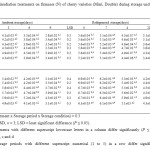 |
Table 1: Effect of gamma irradiation treatments on firmness (N) of cherry varieties (Misri, Double) during storage under ambient and refrigerated conditions. Click here to View table |
Total sugars
Total sugars were also significantly (p≤0.05) higher in ‘Misri’ variety compared to ‘Double’. In case of ‘Misri’ variety, after 0 days of storage; there was no significant (p≥0.05) difference in total sugars among treatments including control. On the other hand, significant (p≤0.05) differences existed in total sugars among treatments in case of ‘Double’ variety after 0 days of storage and the contents were higher in irradiated samples compared to control (Table 2). During storage, total sugars exhibited an increasing trend followed by a decrease in all the treatments including control for both the varieties under both the storage conditions. For both the varieties, total sugars increased up to 3 and 14 days of ambient and refrigerated storage followed by a decrease. Data analysis revealed that in samples of ‘Misri’ variety, there was no significant difference in total sugars among control and irradiated fruits after 3 and 14 days of ambient and refrigerated storage. In case of samples of ‘Double’ variety, this trend in total sugars was observed after 6 and 14 days of ambient and refrigerated storage. The increase in total sugars is attributed either to enzymatic conversion or radiation induced degradation of higher polysaccharides such as starches and pectins in to simple sugars, whereas the subsequent decrease is attributed to oxidation of sugars during respiration (Hussain et al., 2008). Towards the end of the storage, dose of 1.2 kGy proved effective in retention of significantly (p≤0.05) higher levels of total sugars compared to other treatments in both the varieties under both the storage conditions.
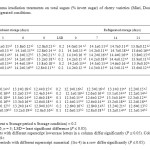 |
Table 2: Effect of gamma irradiation treatments on total sugars (% invert sugar) of cherry varieties (Misri, Double) during storage under ambient and refrigerated conditions. Click here to View table |
Titratable Acidity
Effect of gamma irradiation doses on titratable acidity of cherry varieties is shown in Table 3. For both the varieties after 0 days of storage, there was no significant (p≥0.05) difference in acidity values among treatments including control. This trend in acidity among treatments including control continued up to 3 and 7 days of ambient and refrigerated storage for both the varieties. Similar trend of acidity was reported by Drake and Neven (1997) during initial days of storage of ‘Bing’ and ‘Rainier’ sweet cherries irradiated at doses of 0.15 – 0.9 kGy. During storage, acidity recorded a decreasing trend for both the varieties in all the treatments under both the storage conditions. In case of samples of ‘Misri’ variety, the decrease in acidity was significant (p≤0.05) in all the samples except those irradiated at 1.2 and 1.5 kGy after 3 days of ambient storage; while as under refrigerated conditions after 7 days of storage, trend was significant only in control samples compared to irradiated samples. Beyond 7 days of refrigerated storage the decreasing trend of acidity was significant in all the treatments. On the other hand, the decreasing trend of acidity in samples of ‘Double’ variety as recorded after 3 and 7 days of ambient and refrigerated storage was significant (p≤0.05) in all the treatments including control. Among the treatments, dose of 1.2 kGy was effective in retention of significantly (p≤0.05) higher acidity values during storage of both the cherry varieties under both the storage conditions. This retention of higher acidity values is important in lowering the microbial spoilage of fruits during storage. The loss in acid values is largely due to the utilization of organic acids as respiratory substrates and as carbon skeleton for the synthesis of new compounds during ripening. Accumulation of sugars also contributes to decrease of acidity as a result of increase in total soluble solids acid ratio (Stanley, 1991). The retention of significantly (P ≤ 0.05) high acid values is an indication of delay in senescence due to the irradiation treatment.
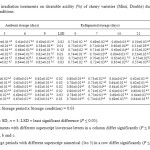 |
Table 3: Effect of gamma irradiation treatments on titratable acidity (%) of cherry varieties (Misri, Double) during storage under ambient and refrigerated conditions. Click here to View table |
Ascorbic Acid
Ascorbic acid content of cherry varieties is shown in Table 4. Ascorbic acid was significantly (p≤0.05) higher in ‘Double’ variety compared to ‘Misri’. There was no significant difference in ascorbic acid among treatments including control for both the varieties after 0 days of storage. During storage significant (p≤0.05) decrease in ascorbic was recorded in all the treatments under both the storage conditions for both the varieties. In case of samples of ‘Misri’ variety, ascorbic acid among treatments after 3 days of ambient storage was significantly lower and marginally (p≥0.05) different in control, 0.3 – 0.9 and 1.5 kGy irradiated samples compared to 1.2 samples. However, for ‘Double’ cherry samples after 3 days of ambient storage; no significant difference existed in ascorbic acid among treatments including control. On the other hand, under refrigerated conditions; for both the varieties there was no significant difference in ascorbic acid among treatments including control even after 14 days of storage. Compared to other treatments, dose of 1.2 kGy was significantly effective in maintaining the higher ascorbic acid content of cherry samples of both the varieties under both the storage conditions towards the end of storage. Thus, it can be inferred that main loss of ascorbic acid is due to storage rather than irradiation. The ascorbic acid loss during storage is known to be due to its antioxidant activity especially under postharvest storage conditions (Davey et al., 2000). Also, the marginally (p≥0.05) lower ascorbic acid found after 0 days in irradiated fruits seems to indicate that radiolysis could accelerate the conversion of ascorbic acid to dehydroascorbic acid (DHA). Wong and Kitts (2001)suggested that the decrease in ascorbic acid in food during ionization can be due to two mechanisms: the first occurring by the direct oxidation of ascorbic acid through the action of OH radicals generated by the water radiolysis in the fruit, and the second by the oxidation of ascorbic acid, since it is consumed during the treatment in order to protect other compounds against the oxidative damage induced by the ionization. The retention of ascorbic acid in irradiated fruits during storage is because of delay in the process of senescence due to irradiation.
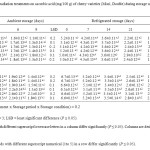 |
Table 4: Effect of gamma irradiation treatments on ascorbic acid (mg/100 g) of cherry varieties (Misri, Double) during storage under ambient and refrigerated conditions. Click here to View table |
Total Anthocyanins
The data on total anthocyanins revealed that ‘Misri’ variety had significantly (p≤0.05) higher anthocyanins than ‘Double’ (Table 5). During storage, the anthocyanins recorded a decreasing trend in both the varieties irrespective of storage condition and treatment; however, the decrease was higher under ambient storage compared to refrigerated storage. Drake and Neven (1997) also reported that objective colour of ‘Rainier’ cherries was reduced at irradiation doses of 0.6 kGy and greater and reduction in ‘Rainier’ red colour was evident visually at an irradiation dose of 0.9 kGy. In case of ‘Misri’ variety at 0 days of ambient storage, anthocyanins were significantly (p≤0.05) lower in control, 0.3 and 0.6 kGy samples than all other irradiated samples. In case of samples of ‘Double’ variety, similar trend in anthocyanins was recorded in control and irradiated 0.3 – 0.9 kGy samples under similar storage conditions respectively. For both the varieties after 9 days of ambient storage, the anthocyanin contents were significantly (p≤0.05) higher in 1.2 and 1.5 kGy samples than the other treatments including control. For samples of ‘Misri’ variety stored under refrigerated conditions, there was no significant decrease in anthocyanins up to 14 days of storage, however in Double variety samples anthocyanins decreased significantly in control, 0.3 and 0.6 kGy irradiated samples over the same storage period. Beyond 14 days of refrigeration, decrease in anthocyanins was significant for both the varieties. Among treatments, decrease in anthocyanins for both the varieties was significantly lower in 1.2 and 1.5 kGy samples even after 28 days of refrigeration. This lower decrease in anthocyanins in samples irradiated at 1.2 and 1.5 kGy is attributed to the combined inhibitory effect of irradiation and low temperature on the rate of anthocyanin degradation (Hussain et al., 2012).
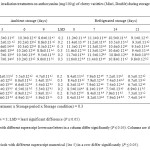 |
Table 5: Effect of gamma irradiation treatments on anthocyanins (mg/100 g) of cherry varieties (Misri, Double) during storage under ambient and refrigerated conditions. Click here to View table |
Weight Loss
The data indicated that weight loss was significantly (p≤0.05) higher in ‘Double’ variety as compared to ‘Misri’ (Table 6). The data analysis also revealed that for ‘Misri’ variety after 3 days of ambient storage, there was no significant difference in weight loss between control, 0.3 and 0.6 kGy irradiated samples. However, in case of ‘Double’ variety samples the weight loss was significantly (p≤0.05) higher in control compared to irradiated samples after 3 days of ambient storage. Further, in case of samples of ‘Misri’ variety stored under refrigerated conditions, weight loss after 7 days was significantly (p≤0.05) higher in control and 0.3 kGy irradiated samples and there was no significant difference of weight loss in samples irradiated between 0.6 – 1.5 kGy. For ‘Double’ variety samples after 7 days of refrigerated storage, weight loss was significantly (p≥0.05) higher in control and 0.3 kGy irradiated samples. With increase in storage period, weight loss increased significantly (p≤0.05) in both the varieties under both the storage conditions; however, weight loss was significantly higher in control samples than irradiated samples throughout the entire storage period. Among irradiation treatments, dose of 1.2 kGy was significantly effective in reducing the weight loss in both the varieties under both the storage conditions. Weight loss in fresh fruits and vegetables is mainly attributed to the loss of water caused by transpiration and respiration processes. The reduction in weight loss in cherries treated with irradiation is because of the effect of the treatment on the respiration rate and in delaying the process of senescence (Hussain et al., 2010; Lester and Whitaker, 1996).
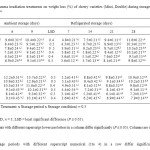 |
Table 6: Effect of gamma irradiation treatments on weight loss (%) of cherry varieties (Misri, Double) during storage under ambient and refrigerated conditions. Click here to View table |
Overall Acceptability
The data analysis indicated that after 0 days of storage (Just after irradiation), there was no significant (p≤0.05) difference in overall acceptability of the two cherry varieties in all the treatments including the control (Table 7). However, as the storage period advanced; overall acceptability decreased significantly in both the varieties under both the storage conditions in all the treatments. For both the varieties after 3 days of ambient storage, overall acceptability was marginally (p≥0.05) different in control and irradiated (0.3 – 0.9, 1.5 kGy) samples and significantly (p≤0.05) higher in 1.2 kGy samples. Almost similar trend in overall acceptability was recorded after 6 days of ambient storage for both the varieties. After 9 days of ambient storage, dose of 1.2 kGy proved to be effective (p≤0.05) in maintaining the higher overall acceptability in both the varieties compared to other treatments. Under refrigerated conditions, there was no significant difference in overall acceptability among treatments for both the varieties even after 14 days of storage. For samples of both the varieties, overall acceptability after 21 days of refrigerated storage was significantly higher in 1.2 and 1.5 kGy irradiated samples compared to all other treatments and this trend in overall acceptability was recorded even after 28 days of storage. The decrease in overall acceptability is related to the decrease in texture, color and loss of volatiles as perceived by the panelists because of rapid senescence and fungal decay. The effect of irradiation on inhibition of fungal growth and delaying the senescence proved significantly (P ≤ 0.05) beneficial in maintaining higher overall acceptability of treated cherries compared with control samples during storage under both the conditions (Hussain et al., 2012).
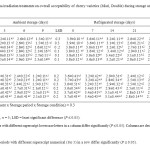 |
Table 7: Effect of gamma irradiation treatments on overall acceptability of cherry varieties (Misri, Double) during storage under ambient and refrigerated conditions. Click here to View table |
Yeast and Mold Count
The decay of Cherry fruits resulting from mould growth is a serious constraint during their storage and marketing and limits the standard shelf life of fruit to a maximum of 3 and 14 day sunder ambient and refrigerated conditions. The data pertaining to yeast and mold count revealed that radiation processing of cherries at doses beyond 0.6 kGy significantly inhibited the yeast and mould growth just after irradiation (Table 8). It is evident from the data that under ambient and refrigerated conditions after 3 and 14 days of storage, no yeast and mould were detected in both the varieties at dose of 1.2 and 1.5 kGy respectively, thereby resulting in around 1.0 log reduction in yeast and mould count after 3 and 14 days of ambient and refrigerated treatment. This beneficial effect of radiations (1.2 and 1.5 kGy) in keeping the yeast and mould count below detection level until 3 and 14 days of ambient and refrigerated storage is attributed to the radiostatic effect of radiations, wherein cells become dormant upon exposure to radiations for extended period by virtue of radiation-induced reparable mutations. Once the damage is repaired, the cells then operate normally (Zhang et al., 2006). With further advancement in storage the yeast and mold counts increased in both the varieties irrespective of treatment under both the storage conditions; however the counts were lower in irradiated samples compared to control. The effectiveness of radiation in reducing the yeast and mould count is also attributed to direct or indirect effects of radiations on cells, primarily attributed to DNA damage (De-Ruiter and Dwyer, 2002). In direct effect radiations cause either single-strand or double strand breaking of DNA molecule, resulting in inability of cell to replicate, thus finally leading to death of the cell. In indirect effect, radiations generate radiolysis products of water, which in turn combine with cell components especially bases of DNA molecule, thereby leading to mutations in cell. The induced mutations can be both reparable and irreparable. Cell death results if the induced mutations are irreparable (Zhang et al., 2006; Baskaran et al., 2007).
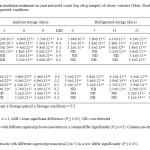 |
Table 8: Effect of gamma irradiation treatments on yeast and mold count (log cfu/g sample) of cherry varieties (Misri, Double) during storage under ambient and refrigerated conditions. Click here to View table |
Decay Percentage
Effect of gamma irradiation treatments on decay percentage of Cherry varieties during storage under ambient, refrigerated and post-refrigerated storage conditions (temperature 25 ± 2 0C, RH 70%) is reported in Table 9 and 10. Data revealed that under ambient conditions, control and irradiated 0.3 – 0.6 kGy samples of both the varieties started decaying after 3 d and were almost fully decayed after 10 d of storage. Samples irradiated at 0.9 kGy started decaying after 6 d and were decayed to the extent of 39.6% in case of ‘Misri’ variety and 44.6% in case of ‘Double’ variety after 10 d of ambient storage. No decay was recorded in samples of both the varieties treated with 1.2 and 1.5 kGy up to 9 d of ambient storage. Comparison of data also revealed that decay percentage was significantly (p≤0.05) higher in ‘Double’ variety than ‘Misri’. Under refrigerated conditions, control samples and those irradiated at 0.3 – 0.6 kGy for ‘Misri’ variety and 0.3 – 0.9 kGy for ‘Double’ variety started decaying after 14 d of storage. Control samples were decayed to the extent of 17.8±1.2 for ‘Misri’ and 20.8±1.2% for ‘Double’ variety after 14 d of storage. In ‘Misri’ variety samples irradiated at 0.9 kGy no decay was recorded up to 21 d of storage compared to 6.4±1.2% in 0.9 kGy samples of ‘Double’ variety. In samples of both the varieties treated with irradiation at 1.2 and 1.5 kGy, no decay was recorded after 28 d of refrigerated storage. The samples of both the varieties were then taken out from the cold storage and kept under ambient conditions to monitor the further decay. Control and 0.3 kGy treated samples were fully decayed after 6 d of pos-refrigerated storage at 25 ± 2 0C, RH 70% (Table 10). In fruits of both the varieties treated with irradiation at 1.2 and 1.5 kGy, no decay was recorded even after 6 d of post-refrigerated storage at 25 ± 2 0C, RH 70%. After 7 d of post-refrigerated storage, the samples of 1.2 and 1.5 kGy were decayed to the extent of 7.3±1.2% and 9.3±1.2% in ‘Misri’ variety and 10.3±1.2% and 12.5±1.2% in ‘Double’ Variety The investigation showed that gamma irradiation treatment of cherry at doses 0.3 and 0.6 kGy was not found effective with respect to delaying the fungal growth and shelf life extension of Misri and Double cherry. Radiation treatment of cherry at1.2 and 1.5 kGy proved to be effective in maintaining the storage quality and significantly (p≤0.05) delaying the fungal decay of the cherry varieties under both the storage conditions. However, dose of 1.2 kGy was found to be better compared to 1.5 kGy due to decrease in firmness observed in cherry samples irradiated at 1.5 kGy compared to 1.2 kGy samples. Further, dose of 1.2 kGy maintained significantly (P ≤ 0.05) higher levels of total sugars, ascorbic acid, overall acceptability and lower levels of weight loss in cherry fruits of both the varieties during storage under ambient as well as refrigerated conditions. Under ambient conditions, dose of 1.2 and 1.5 kGy delayed the decaying of the cherry fruits of both the varieties up to 9 days. Under refrigerated conditions, cherry samples of control and those irradiated in the range of 0.3 – 0.9 kGy started decaying after 14 days of storage. No decay was observed in 1.2 and 1.5 kGy samples of both the varieties up to 28 days of refrigerated storage. The treatments of 1.2 and 1.5 kGy gave a further extension of 6 days in shelf life of cherry varieties during post-refrigerated storage at 25 ± 2 0C, RH 70% following 28 days of refrigeration. Thus, radiation processing of Kashmiri Cheries at 1.2 kGy can prove beneficial in facilitating the marketing of the fruit to distant places other than the local markets, thereby benefiting the growers.
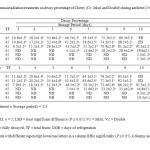 |
Table 9: Effect of gamma irradiation treatments on decay percentage of Cherry (Cv. Misri and Double) during ambient (25±2 0C, RH 70%) storage Click here to View table |
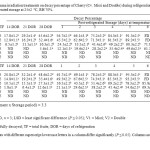 |
Table 10: Effect of gamma irradiation treatments on decay percentage of Cherry (Cv. Misri and Double) during refrigeration and post-refrigerated storage at 25±2 0C, RH 70%. Click here to View table |
Rreferences
- Aneja, K. R., 1996, Experiments in microbiology, plant pathology, tissue culture and mushroom cultivation. 2nd edn, New Age International (P) Ltd., New Delhi.
- Anon., 2009 -2010, Annual Report, Department of Horticulture, Directorate of Horticulture, Jammu and Kashmir, Rajbagh, Srinagar, p 101–102.
- Baskaran, R., Devi, A. U., Nayak, C. A., Effect of low-dose gamma irradiation on the shelf-life and quality characteristics of minimally processed potato cubes under modified atmosphere packaging. Rad Phy Chem 76: 1042–1049 (2007).
CrossRef - Cochran, W. G., Cox, G. M., Experimental designs. John Willey and Sons. Inc, New York, pp 95–100 (1992).
- Davey, M.W., Montagu, M.V., Inze, D., Sanmartin, M., Kanellis, A., Smirnoff, N., Benzie, I.J.J., Strain, J.J., Favell, D., Fletcher, J., Plant L-ascorbic acid: chemistry, function, metabolism, bioavailability and effects of processing. J Sci Food Agric 80: 825–860 (2000).
CrossRef - DeRuiter, F. E., Dwyer, J., Consumer acceptance of irradiated foods: dawn of a new era? Food Ser Technol 2: 47–58 (2002).
CrossRef - Drake, S.R., Nelson, L.G., Comparison of alternative postharvest quarantine treatment for sweet cherries. Postharvest Biol Technol 20: 107 – 114 (2000).
CrossRef - Drake, S. R., Neven, L. G., Quality response of Bing and Rainier sweet cherries to low dose electron beam irradiation. J Food Proc Pres 21: 345 – 351(1997).
CrossRef - Drake, S. R., Moffitt, H. R., Eakin, D. E., Low dose irradiation of Rainier sweet cherries as a quarantine treatment. J Food Proc Pres 18: 473 – 481(1994).
CrossRef - Fan, X., Niemira, B. A., Sokorai, K.J. B., Sensorial, nutritional and microbiolo- gical quality of fresh cilantro leaves as influenced by ionizing radiation and storage. Food Res Int 36: 713–719 (2003).
CrossRef - Guisti, M. M., Wrolstad, R.E., 2001, Characterization and measurement of anthocyanins by UV– visible spectroscopy. In: Current Protocols in Food Analytical Chemistry. John Wiley and Sons Inc, New York, Hallman, G., Expanding radiation quarantine treatments beyond fruit flies. Agric Forest Entomol 2: 85–95 (2000).
- Hong, Y. H., Park, J. Y., Park, J. H., Chung, M. S., Kwon, K. S., Chung, K., Inactivation of Enterobacter SakaZakii, Bacillus cereus and Salmonella typhi- murium in powdered weaning food by electron beam irradiation. Rad Phy Chem 77: 1097–1100 (2008).
CrossRef - Hussain, P.R., Dar, M. A., Wani, A. M., Impact of radiation processing on quality during storage and post-refrigeration decay of plum (prunus domestica L.) Cv. Santaroza. Rad Phy Chem 85: 234- 242 (2013).
CrossRef - Hussain, P. R., Dar, M. A., Wani, A. M., Effect of edible coating and gamma irradiation on inhibition of mould growth and quality retention of strawberry during refrigerated storage. Int J Food Sci Technol 47: 2318–2324 (2012).
CrossRef - Hussain, P.R., Meena, R.S., Dar, M. A., Wani, A. M., Carboxymethyl cellulose coating and low- dose gamma irradiation improves storage quality and shelf-life of pear (Pyrus communis L., Cv, Bartlett/William). J Food Sci 75: 586–596 (2010).
CrossRef - Hussain, P. R., Dar, M. A., Meena, R. S., Mir, A. M., Shafi, F., Wani, A. M., Changes in quality of apple (Malus domestica) cultivars due to gamma irradiation and storage conditions. J Food Sci Technol 45(1): 44–49 (2008).
- Jessup, A. J., Gamma irradiation as a quarantine treatment for sweet cherries against Queensland fruit fly. HortSci 25(4): 456 – 458 (1990).
- Kim, M. S., Kim, K. H., Yook, H. S., The effects of gamma irradiation on the microbiological, physicochemical and sensory quality of peach (Prunus persica L. Batsch Cv. Dangeumdo). J Korean Soc Food Sci Nutr 38: 364 – 371 (2009).
CrossRef - Lacroix, M., Ouattara, B., Combined industrial processes with irradiation to assure innocuity and preservation of food products – a review. Food Res Int 33: 719–724 (2000).
CrossRef - Lester, G. E., Whitaker, B. D., Gamma ray induced changes in hypodermal mesocarp tissue plasma membrane of pre and post-storage muskmelon. Physiol Plant 98: 265–270 (1996).
CrossRef - McDonald, H., McCulloch, M., Caporaso, F., Winborne, I., Oubichon, M., Rakovski, C.,Prakash, A., Commercial scale irradiation for insect disinfestations preserves peach quality. Rad Phy Chem 81: 697 – 704 (2012).
CrossRef - Miller, G. L., Use of dinitrosalicylic acid reagent for determination of reducing sugars. Anal Chem 31:426–428 (1959)
CrossRef - Molins, R. A., 2001, Food Irradiation: Principles and Applications. 2nd ed. Wiley Interscience, New York.
- Prakash, A., Manley, J., Descota, S., Caporaso, F., Foley, D. M., The effect of gamma irradiation on the microbiological, physical and sensory qualities of diced tomatoes. Rad Phy Chem 63: 387–390 (2002).
CrossRef - Ranganna, S., 1986, Handbook of analysis and quality control for fruit and vegetable products. 2nd ed. Tata McGraw Hill Publ Co New Delhi
- Stanley, J. K., 1991, Post-harvest physiology of perishable plant products. Van Nestrand Reinhold, New York
- Teets, A. S., Sundararaman, M., Were, L. M., Electron beam irradiated almond skin powder inhibition of lipid oxidation in coked salted ground chicken breast. Food Chem 111: 934 – 941 (2008).
CrossRef - Wani, A. M., Hussain, P. R., Meena, R.S., Dar, M.A., Effect of gamma irradiation and refrigerated storage on the improvement of quality and shelf-life of pear (Pyrus communis L., Cv. Bartlett/William). Rad Phy Chem 77: 983–989 (2008).
CrossRef - Wong, P. Y. Y., Kitts, D. D., Factors influencing ultraviolet and electron beam irradiation- induced free radical damage of ascorbic acid. Food Chem 74: 75–84 (2001).
CrossRef - Zhang, L., Zhaoxin, L., Fengxia, L., Xiaomei, B., Effect of gamma irradiation on quality maintaining of fresh-cut lettuce. Food Cont 17: 225–229 (2006).
CrossRef

This work is licensed under a Creative Commons Attribution 4.0 International License.





